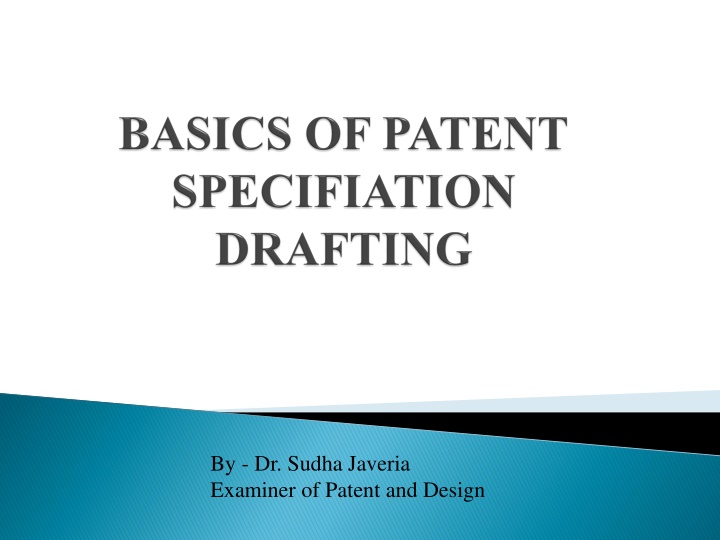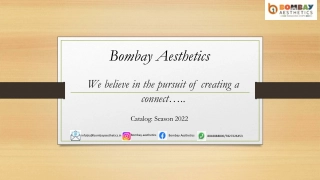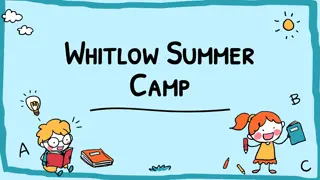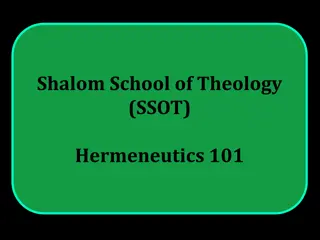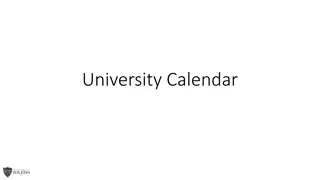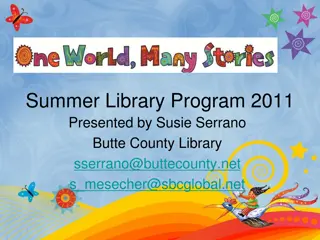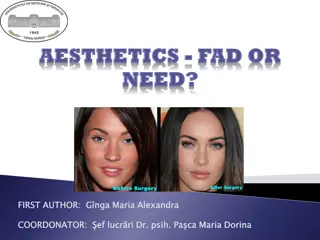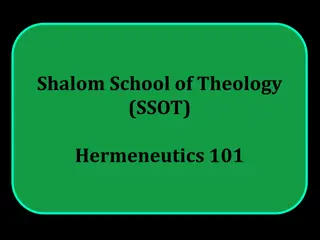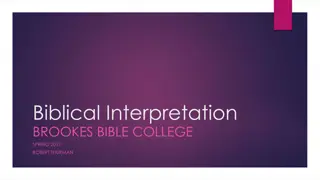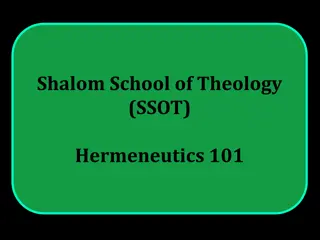Hermeneutics and Aesthetics in Summer Semester 2019-2020
The lecture delves into the complexities of hermeneutic understanding, the relation between subject and object extremes, intentionality in consciousness, and the ontological-existential structure of Dasein according to key philosophers like Georgia Warnke, Edmund Husserl, and Martin Heidegger.
Download Presentation

Please find below an Image/Link to download the presentation.
The content on the website is provided AS IS for your information and personal use only. It may not be sold, licensed, or shared on other websites without obtaining consent from the author.If you encounter any issues during the download, it is possible that the publisher has removed the file from their server.
You are allowed to download the files provided on this website for personal or commercial use, subject to the condition that they are used lawfully. All files are the property of their respective owners.
The content on the website is provided AS IS for your information and personal use only. It may not be sold, licensed, or shared on other websites without obtaining consent from the author.
E N D
Presentation Transcript
By - Dr. Sudha Javeria Examiner of Patent and Design
WHAT IS A PATENT A PATENT IS A GRANT BY SOVEREIGN OR STATE PERSON GIVING USING,OFFERING FOR SALE, SELLING OR IMPORTING AN INVENTION LIMITED PERIOD DISCLOSING Such that any one trained in the art can reproduce the invention. A PATENT IS A GRANT BY SOVEREIGN OR STATE TO A PERSON GIVING RIGHT TO EXCLUDE USING,OFFERING FOR SALE, SELLING OR IMPORTING AN INVENTION FOR A LIMITED PERIOD, IN EXCHANGE FOR DISCLOSING IT IN A PATENT Such that any one trained in the art can reproduce the invention. TO A RIGHT TO EXCLUDE OTHERS FROM MAKING, OTHERS FROM MAKING, FOR A , IN EXCHANGE FOR IT IN A PATENT SPECIFICATION SPECIFICATION OWNER HAS A QUALIFIED RIGHT TO USE THE INVENTION OWNER HAS A QUALIFIED RIGHT TO USE THE INVENTION
Patentability criteria:- Patent applications are decided on the basis of novelty, inventive step , industrial application, as well as on the requirements that the description should be sufficient and should support the claims. section 3&4 The statutory exclusions need also be considered-
THE INVENTION IS NOVEL PRIOR ART INVENTION
ANTICIPATION CLAIMED INVENTION PRIOR ART
WHEN INVENTIVE ? INVOLVES TECHNICAL ADVANCEMENT COMPARED TO EXISTING KNOWLEDGE OR HAVING ECONOMIC SIGNIFICANCE OR BOTH AND THAT MAKES THE INVENTION NOT OBVIOUS TO A PERSON SKILLED IN THE ART.
OBVIOUSNESS/LACK OF INVENTIVE STEP PRIOR ART INVENTION KNOWLEDGE IN ART
An invention is capable of industrial application if It can be made or used in industry
What is a patent specification? A document providing technical details and legal protection describes the invention provides the extent/scope of monopoly protection
PATENT SPECIFICATION MAY BE provisional providing basic idea of the invention without details as to working of invention and claims or complete providing details of invention, best mode of working, claims, abstract
What is complete Specification? Analysis of Section 10(4) of Act Section 10(4): Every complete specification should: a) fully and particularly describe the invention and its operation or use and the method by which it is to be performed; disclose the best method of performing the invention which is known to the applicant and for which he is entitled to claim protection; and end with a claim or claims defining the scope of invention for which protection is claimed; be accompanied by an abstract to provide technical information on the invention b) c) d)
Patent Specification - Techno-legal doc Unity Of Invention - Single Inventive Concept Clarity of Disclosure - State Clearly And Distinctly The Nature And Limits Of The Claims Sufficiency Of Disclosure - Claims should be supported by Written Description. Biological Material - Geographical Origin
Structure of Patent specification Title Field of Invention Background of the invention/Prior Art Object of Invention Summary of invention Detailed Description of Invention Claims Drawings Abstract Deposit
TITLE A concise statement providing the crux of the invention Care should be taken to incorporate all major aspects claimed Product-Process-Apparatus Examples Brush - Cleaning Article Pen - Writing Instrument
FIELD OF THE INVENTION More details than the title Provides utility Sometimes used as a tool for search in the absence of abstract
BACKGROUND AND PRIOR ART to search the relevant technical field for published documents to discuss all patent/non patent documents published any where in the world, prior knowledge and use in the same technical field to distinguish the invention from the known/prior art Disadvantages or problems existing with the prior art that the invention solves
OBJECTS OF THE INVENTION Provides purpose of the invention Main object(s) Essential aspects and preferred/optional aspects
SUMMARY OF THE INVENTION Gist of proposed invention Gist of proposed solution for one or more technical problems
DETAILED DESCRIPTION OF INVENTION Sets out best mode of performing the invention Describes the invention in greater detail with examples/illustration/tables/graphs /Sequence listing etc Description sufficient to enable skilled person to put the invention into practice
SEQUENCE LISTING FORMAT <110> Applicant Name <120> Title of Invention : <130> File reference : : *<140> Current Patent Application : : *<141> Current filing date : *<150> Earlier Patent Application : - *<151> Earlier Appln. Filing Date : - PCT/ IN . <160> Number of SEQ ID Nos. : *<170> Software : 2 <210> Information for SEQ ID No. : <211> Length : <212> Type : <213> Organism 1 22 DNA
{ For modified bases/amino acids incorporate 221 and 222 } *<221>: Name/Key *<222>: Location *<300> Publication Information : *<301> Authors : *<302> Title (Title of Publication) *<303> Journal (Journal name in which data published *<304> Volume (Journal volume in which data published) *<305> Issue (Journal issue No. in which data published *<306> Pages (Journal page nos. in which data published *<307> Date (Journal date in which data published (CCYY MM DD) *<308> Database accession[Accession no. assigned by database incl. (CCYY MM DD) incl. Database name}
*<309> Database entry date {Date of entry in database ((CCYY MM DD)} *<310>Document No.(Document no.for patent type citations only) *<311> Filing date Document filing date. For patent type citations only.) *<312> Publication date : ( Document publication date. For patent type citations only.) *<313> Relevant residues in SEQ ID NO: X : from to : : <400> SEQ ID NO. : 1 sequence ggatccaata cgatcactcg ac 22 (As per rules triplet codons are to be grouped as triplets, otherwise groups of 10 with a gap in between are to be given).
Structuring Patent Claim Identify essential elements of the invention Claims should relate to one invention/embodiment within one inventive concept Say less to protect more Use broader terms as far as applicable Define interrelationship of the components Basis on the disclosure
CLAIMS The main claim defines the essential features Sub-claims define the preferred/optional/additional features one or more claims may be presented in dependent form Any dependent claim which refers back to more than one other claim is considered a multiple dependent claim.
Claim 1 Claim 2 Claim 3 Claim 4
Example I/We claimed 1. A shampoo composition comprising 20- 30% of at least one Surfactant; 5-15% of at least one conditioning agent; 1-3% of atleast one anti fungal agent and water. 2. The shampoo composition as claimed in claim 1, wherein the antifungal agent is selected from a group consisting of pyrazole, imidazole, triazole, tetrazole and pentazole. 3. The shampoo composition in claim 1 wherein said anti fungal agent is imidazole.
The claim has 3 parts: preamble transitional phrase body A claim is written as a single sentence
Preamble Provide a category for the invention Eg.: A nucleic acid . A monoclonal antibody which is reactive to ..
Transition Follows the preamble May begin with a comma Comprising Eg A shampoo composition comprising 20- 30% of at least one Surfactant; 5-15% of at least one conditioning agent; 1-3% of atleast one anti fungal agent and water. Consisting of or consisting essentially of Eg A fusion protein, consisting a polypeptide with a molecular weight of 1110 to 114 kilodaltons which is a product of a retinoblastoma gene.
Body Follows the transitional phrase Provides the main feature/features of the process/product and the inter relation between the components The shampoo composition as claimed in claim 1, wherein the antifungal agent is selected from a group consisting of pyrazole, imidazole, triazole, tetrazole and pentazole.
Avoid relative words like Fast, slow, long, short, tall, wide, perfect, complete, thin, strong, flat, high etc. Unless the relationship lies with another recited element in the claim wherein the first oligo nucleotide is shorter than the second oligo nucleotide
Avoid negative limitations in claims unless disclaiming or that the same cannot be provided in any other manner a monoclonal antibody which is reactive to antigen A but not to antigen B State limitations in the positive terms a short oligo nucleotide of up to 14 bp
Expressions like "preferably", "for example", "such as" or "more particularly" should be looked at carefully to ensure that they do not introduce ambiguity. A process for . Wherein annealing is carried out at a temperature About more preferably at ..
Support of the claim language to be reflected in the specification. every claim should have adequate support in the specification Words and terminology should be consistent Eg The amino acid sequence is written in the abbreviation code recognized in the art. Single-letter abbreviations for the amino acid residues are: A=Alanine, C=Cysteine, D=Aspartic acid, E=Glutamic acid, F=Phenylalanine, G=Glycine, H=Histidine, I=Isoleucine, K=Lysine, L=Leucine, M=Methionine, N=Asparagine, P=Proline, Q=Glutanine, R=Arginine, S=Serine, T=Threonine, V=Valine, W=Tryptophane and Y=Tyrosine.
Drawings (Rule 15) Submitted on separate sheets made on a scale sufficiently large to show the invention clearly Dimensions must not be marked Sequentially numbered must not have any descriptive matter unless they contain flow diagrams Consistent Labeling
Abstract Concise summary of the invention Must start with the title of Invention indicate clearly the technical field and the technical problem and solution 150 words Reference can be made to formula or drawing
DEPOSIT Any invention involving a biological material in the specification should be deposited with International Depository Authority (IDA) followed by obtaining date of deposition and accession number. The details needs to be incorporated in the complete specification; Deposit must be made on or before the date of Indian Filing. Geographical Origin of the material must be disclosed
CHECK-LIST VERIFY THE FOLLOWING VERIFY THE FOLLOWING Conduct search Has it been published, if so, what extent? Ascertain whether complete or provisional is to be filed Enlist problems in prior art What is the problem sought to be solved by the invention? Is the solution novel, non-obvious? Non-patentable items Specific Indian requirements, such as Deposition, Source and origin etc. Collect all details, such as Experimental data/examples/tables/graphs
CLAIMS 1. A peptide comprising a first domain and a second domain, wherein the first domain comprises the translocation sequence of SEQ ID NO:35 which facilitates active transport across a biological membrane and the second domain comprises at least a biologically active portion of an insulin polypeptide. 2. The peptide of claim 1, wherein the translocation sequence binds an aminoglycan. 3. The peptide of claim 2, wherein the aminoglycan is heparin or chondroitin sulfate. 4. The peptide of claim 1, wherein the chimeric peptide translocates a physiological barrier. 5. The peptide of claim 4, wherein the physiological barrier is the gastrointestinal barrier or the blood-brain barrier.
11. A method of increasing the intracellular concentration of insulin in a eukaryotic cell, the method comprising: (a) providing the peptide of claim 1; and (b) contacting the cell with the peptide under conditions promoting active metabolism of the eukaryotic cell. 12. A method of decreasing the intracellular concentration of glucose in a eukaryotic cell, the method comprising: (a) providing the peptide of claim 1; and (b) contacting the cell with the peptide under conditions promoting active metabolism of the eukaryotic cell. 13. A method of increasing the serum insulin concentration in a subject, comprising administering to the subject the peptide of claim 1. 14. A method of decreasing the serum glucose concentration in a subject, comprising administering to the subject the peptide of claim 1
15. The chimeric peptide of claim 1, wherein the second domain comprising at least a biologically active portion of an insulin polypeptide still has at least one function of native insulin. 16. The chimeric peptide of claim 15, wherein the at least one function of native insulin is decreasing blood glucose levels.
